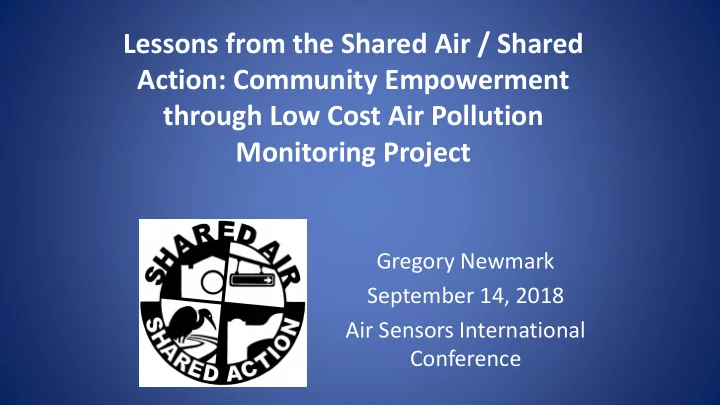

Lessons from the Shared Air / Shared Action: Community Empowerment through Low Cost Air Pollution Monitoring Project Gregory Newmark September 14, 2018 Air Sensors International Conference
Air Quality is Important • Annual premature deaths from air pollution – 3.7 million globally (WHO 2014) • Mostly in middle- and low-income countries – 200,000 in the US (Caiazzo et al. 2013) • 53,000 from tailpipe emissions (largest share) • 52,000 from electricity generation (second largest)
Air Quality is Important • Annual social cost of air pollution – $3.55 trillion globally for PM 2.5 alone (WB 2016) • Those losses are growing with urbanization
How do we know about our air? • Federal Reference Monitors (FRMs) in Kansas
Original Low Cost Air Monitor • Canary in a Coal Mine
Environmental Data Monitoring • Key Technological Developments – Sensor miniaturization – Wireless connectivity – Cloud-storage – Internet delivery – Reduction in unit cost!
Environmental Data Monitoring Old School New School
Environmental Data Monitoring • WU Stations
Potential of Low-Cost Sensors • New market entrants – Individuals, non-profits, municipalities, schools – Democratization of information • Higher deployment densities – No longer single point, but net – Fine-grained mapping of conditions • Better environmental management (ideally)
Eight Initial Partners Type Name EJ Mission University University of Illinois, Chicago UIC Environmental health disparities and risk assessment Kansas State University KSU Sustainability, remediation, community outreach Non-Profit Delta Institute Sustainable development Respiratory Health RHA Advocacy and education Association related to lung disease Community Alliance for a Greener South AGSL Environmental improvement/ Loop sustainability for South Loop Little Village Environmental LVEJO * EJ, self‐determination Justice Organization for Little Village Southeast Environmental SETF * EJ/sustainable growth for Task Force Southeast community People for Community PCR * EJ for Riverdale Community Recovery
Community Info • Lower Income • Far from monitors • Many polluters – coal ash repositories – metal shredders – trucking and rail – landfills • High rates of asthma among children
Key Points • Lived environmental experience in these neighborhoods does not accord with existing (limited) information on air quality • Low cost monitors can empower community members* to explore local air quality *Note: While traditionally this would be called Citizen Science, we are reframing to community member to avoid the legal connotations associated with citizen
Research Plan • Test low-cost monitors in four neighborhoods over four weeks in winter and in summer • Compare low-cost monitors with Federal Reference Method (FRM) or Federal Equivalent Method (FEM) samplers Met One E-FRM
Challenge #1: Monitor Selection
Monitor Selection (Particulates) • Particulate Matter – MetOne Neighborhood Monitor – PurpleAir PM Sensor – AirBeam
Monitor Selection (Gaseous) • Carbon Monoxide and Nitric Oxide – Terrier • Nitrogen Dioxide and Ozone – Aeroqual 500
Monitor Selection • Rapidly evolving field without standardization – Providers generally very accessible • Very difficult to navigate for non-experts – EPA and SCAQMD Testing very helpful • Market entrants come and go – Terrier is already off the market • Disjunction between what low cost sensors monitor and community concerns – CAPS vs. VOCs
Challenge #2: Air Monitoring Plans
Community Air Monitoring Plans • Diesel PM from NATA
Community Air Monitoring Plans F: Fixed air monitoring sites; M: Mobile routes; Pink Dots: Intersections/Roadways of concern to community; Green Text: Tiers of DPM concentrations (high to low); Orange Text: Tiers of toluene concentrations (high to low)
Air Monitoring Plans • Require bringing together an array of data – Local knowledge and external data sources • Requires community education on air quality – Particularly to match monitors to problems • Plans dependent on community partners – Hosts for stationary monitors – Participants for mobile monitoring • Trade-offs between detail and coverage • Iterative process and ideally on-going
Challenge #3: Monitoring • All the devices are different – We provided training guidance and protocols – Set up was complicated – particularly registration – New devices or new apps added confusion • All require ancillary gear • Data protocols vary among devices – Downloading – automated vs. cloud – File types and structures – APIs change
Monitoring • Need to bring data together in “real time”
Monitoring • Mobile data not uploaded immediately – Our protocol only looked for the previous day • Naming conventions not adhered to – Lots of retroactive work to track down data – Manufacturers very helpful in getting us access
Challenge #4:Data Quality • Data Cleaning – Lots of work clearing out test readings – Lots of effort on QAQC with STI guidance – Removing outliers – Selecting best feed for Purple Air
Data Quality
Data Quality – Good Alignment
Data Quality – Clear Divergence
Data Quality - Unclear
Data Quality • Need for standardized cleaning protocols – Ideally conducted by the device – At a minimum, problematic data should be flagged • What, if any, data should be excluded? – July 4 th saw a spike in PM – Daily spike at one location due to smoke breaks
Challenge #5: Data Interpretation • What can we say about air quality? – Should we present our data with AQI bands? – Can we argue there is an air quality problem? – Do we need to calibrate our instruments? • Can we use these devices for advocacy and policy making at the local level? • Challenge for community groups to handle torrents of data • Need for more education on air quality
Thank you • Gregory Newmark • gnewmark@ksu.edu • 510-282-8413
Recommend
More recommend